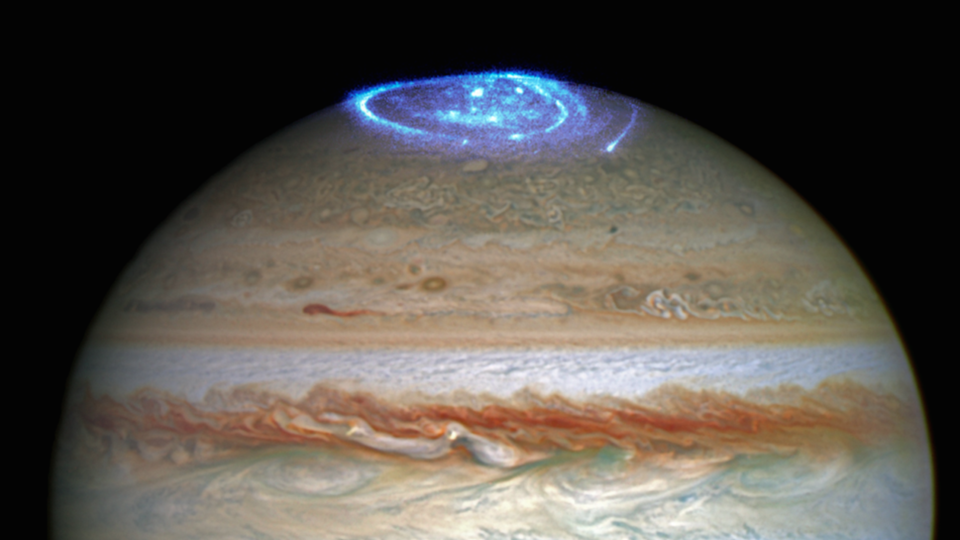Universe Update
JEDI Insights into Jupiter’s Aurora

As sky-covering light shows go, few sights on Earth can match our auroras. These displays of intense color occur near our north and south poles as material from the Sun (in the form of the solar wind) interacts with the Earth’s magnetic field, resulting in ionized particles giving off energy at wavelengths that can be seen as visible light.
We’re not the only planet putting on polar light shows! Jupiter also has a magnetic field vastly stronger than Earth’s that powers its own aurora. Much like its storms and moons, Jupiter’s aurora is also the largest in the Solar System—multiple Earths could fit within it! From Earth, we have determined that Jupiter’s aurora is hundreds of times more energetic than ours, but we cannot determine whether Jupiter’s light show is powered by the same processes as on Earth.
To study our red-spotted neighbor, NASA launched the Juno spacecraft in August 2011, and it entered a highly elliptical orbit (HEO) around Jupiter in July 2016. Rather than a circular orbit similar to well-known Earth orbiting satellites such as the International Space Station and the GPS constellation, an elliptical orbit was selected to minimize the amount of time Juno would be exposed to Jupiter’s extremely hostile radiation belts, and to maximize Sun exposure on its solar arrays to keep its batteries charged. The current orbital profile provides windows for performing observations at perijove (the point in the orbit closest to Jupiter) at 53 day intervals, and these are the best opportunity to study Jupiter’s auroras!
To investigate how Jupiter’s magnetic fields accelerate and energize particles, the Applied Physics Laboratory (APL) at Johns Hopkins University built the Jupiter Energetic-particle Detector Instrument (JEDI) payload to measure properties of high-energy particles (30-1,000 keV). By observing the types of particles (e.g., electrons, ions including bare protons, helium, oxygen, and sulfur, as well as neutral atoms), energy level, and direction of travel, the APL team was able to piece together a better understanding of how Jupiter’s planetary environment creates the particle flows that create its massive light show.
On Earth, multiple processes are known to create the lights. Intense auroras (called “discrete aurora”) are created by coherent acceleration of electronics along magnetic field lines. Less intense auroras are generally caused by two processes: the ‘diffuse aurora’ caused by wave scattering of trapped electrons, and the “Alfvénic aurora” caused by turbulent acceleration of electronics along magnetic field lines.
Prior to measuring Jupiter’s particle flows directly, it had been theorized that due to the magnitude of Jupiter’s powerful aurora, it must be primarily driven by the discrete process that generates Earth’s most intense aurora. However, the planet named for the mightiest of the Roman gods had a surprise in store.
This week’s paper by the JEDI team analyzes data from the first four perijove passes, and contradicts prior beliefs about the mechanics behind Jupiter’s aurora. While strong electron beams were observed, several features of the beams were unexpected. Sufficient downward energy fluxes were seen to explain Jupiter’s auroral intensity, but did not match predictions in terms of energy peaks. Unlike Earth’s sharply peaked energy profile, Jupiter’s is made of up particles with a broader spectrum of energy. In addition, while the downward flows are sufficient in magnitude to explain Jupiter’s aurora, upward energy fluxes have even greater magnitude!
One possibility to explain the diversity in energy profiles observed is that multiple physical drivers are at work simultaneously in the Jovian environment. Another possible explanation is that the accelerations begin as discrete beams (as on Earth), but the amount of power being driven by Jupiter’s intense magnetic field generates instability resulting in the beams becoming stochastic (or as a non-scientist might say, random).
These surprises have provided a direction for the JEDI team to focus their observations during future orbits, and generate insight into the factors that drive the magnetic environment around Jupiter.